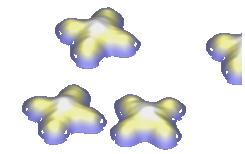



|
© T. G. Gopakumar, IITK |

|
Molecular Functional Materials Research Group |

|
Schematic diagram showing the working principle of STM, microscopic view of tip-sample interface is shown in the circle. Inset is the top view of the piezo tube scanner, x -, x +, y -, y + and z represent the electrodes on and inside the piezo tube. |
|
The basic working principle of STM is illustrated above. A sharp metallic tip usually made of W/Pt-Ir is brought in close vicinity (0.1-10 nm) of a conducting sample. If a small voltage is applied between the sample and the tip, the electrons (quantum mechanically) tunnel through the gap and thus an electrical current can be measured. The direction of the tunnelling current is defined by the polarity of the voltage. The tunnelling current is then amplified by the current amplifier, which is compared with a reference value and a corresponding voltage is fed to the z-piezo. This difference is then amplified again to drive the piezo in the z-axis. The position of the tip in three dimensions is accurately controlled by the piezoelectric tube scanner, which selects the directions and elongations of scan according to the potential applied to corresponding electrodes. The inset shows the top view of piezo tube scanner. x-, x+, y-, y+ and z are electrodes. The feedback system constantly adjusts the tip-sample distance in real time, so that when the tip is moved to a point (x, y) over the sample, the signal Vz(x, y) fed to the piezo scanner is proportional to the local movement of the sample surface from the ideal plane x, y (z = 0). This makes possible to use the values Vz(x, y) to map the surface topography. This is continued in the x and y axis and produces finally the image from STM. This type of imaging is called a constant-current-mode, where the reference value of the current is kept constant throughout the experiment and produces the topography of the surface. It is also possible to use a slower/no feedback response for the tip height, so that the tip height is kept constant throughout the measurement and only the variation in the current over the x, y plane is measured. This mode of operation is called constant-height-mode. The advantage of this mode over the constant current mode is the stability of the tip; this mode has a disadvantage that the tip crashes on irregular surfaces. So in a practical STM operation one uses not the extreme conditions of feedback on (constant current mode) or off (constant height mode) rather an operation with slower feedback. This provides stability of the tip as well as control over the irregular surface topography. |
|
Scanning Tunneling Microscope |